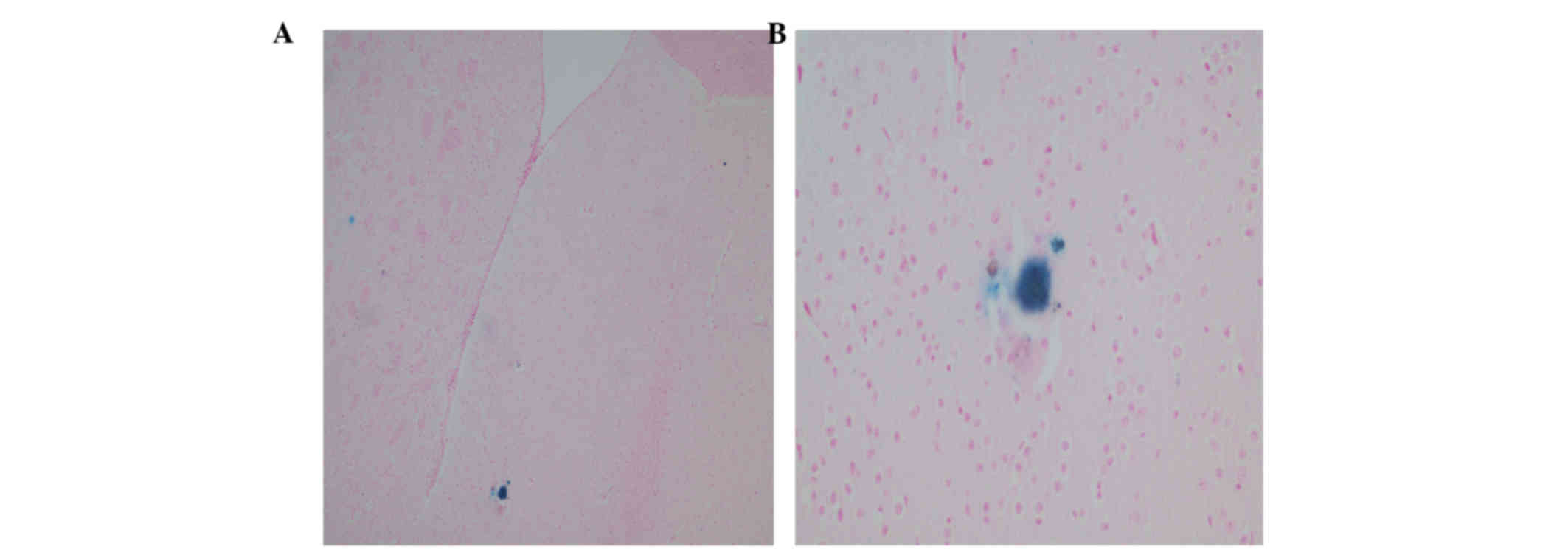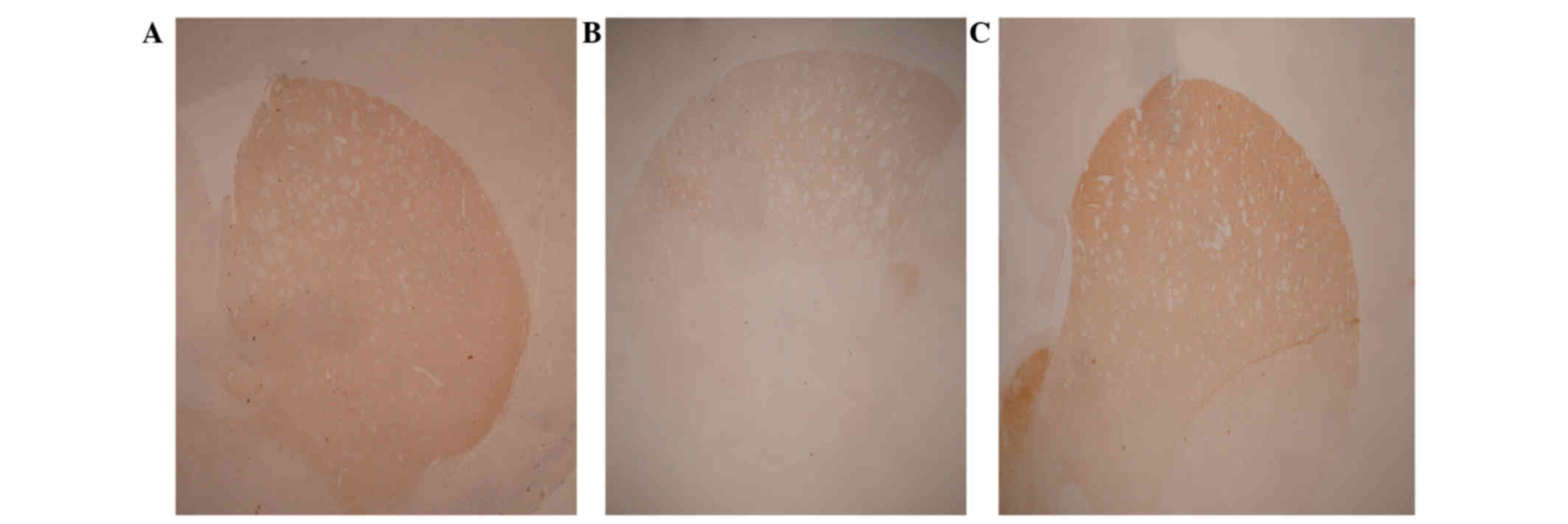|
1
|
Chen RC, Chang SF, Su CL, Chen TH, Yen MF,
Wu HM, Chen ZY and Liou HH: Prevalence, incidence, and mortality of
PD: A door-to-door survey in Ilan county, Taiwan. Neurology.
57:1679–1686. 2001. View Article : Google Scholar : PubMed/NCBI
|
|
2
|
Aarsland D, Londos E and Ballard C:
Parkinson's disease dementia and dementia with Lewy bodies:
Different aspects of one entity. Int Psychogeriatr. 21:216–219.
2009. View Article : Google Scholar : PubMed/NCBI
|
|
3
|
Samii A, Nutt JG and Ransom BR:
Parkinson's disease. Lancet. 363:1783–1193. 2004. View Article : Google Scholar : PubMed/NCBI
|
|
4
|
Sengupta U, Guerrero-Muñoz MJ,
Castillo-Carranza DL, Lasagna-Reeves CA, Gerson JE,
Paulucci-Holthauzen AA, Krishnamurthy S, Farhed M, Jackson GR and
Kayed R: Pathological interface between oligomeric alpha-synuclein
and tau in synucleinopathies. Biol Psychiatry. 78:672–683. 2015.
View Article : Google Scholar : PubMed/NCBI
|
|
5
|
Shulman JM, De Jager PL and Feany MB:
Parkinson's disease: Genetics and pathogenesis. Annu Rev Pathol.
6:193–222. 2011. View Article : Google Scholar : PubMed/NCBI
|
|
6
|
Toulouse A and Sullivan AM: Progress in
Parkinson's disease-where do we stand? Prog Neurobiol. 85:376–392.
2008. View Article : Google Scholar : PubMed/NCBI
|
|
7
|
Street V and Stacy M: Dopamine
agonistsHandbook of Parkinson's Disease. Pahwa R and Lyons KE: 4th.
Informa Healthcare; New York, NY: pp. 335–348. 2007
|
|
8
|
Goya R Laguna, Tyers P and Barker RA: The
search for a curative cell therapy in Parkinson's disease. J Neurol
Sci. 265:32–42. 2008. View Article : Google Scholar : PubMed/NCBI
|
|
9
|
Inden M, Kim D, Qi M, Kitamura Y,
Yanagisawa D, Nishimura K, Tsuchiya D, Takata K, Hayashi K,
Taniguchi T, et al: Transplantation of mouse embryonic stem
cell-derived neurons into the striatum, subthalamic nucleus and
substantia nigra, and behavioral recovery in hemiparkinsonian rats.
Neurosci Lett. 387:151–156. 2005. View Article : Google Scholar : PubMed/NCBI
|
|
10
|
Hanson LR and Frey WH II: Intranasal
delivery bypasses the blood-brain barrier to target therapeutic
agents to the central nervous system and treat neurodegenerative
disease. BMC Neurosci. 9:(Suppl 3). S52008. View Article : Google Scholar : PubMed/NCBI
|
|
11
|
Chao YX, He BP and Tay SS: Mesenchymal
stem cell transplantation attenuates blood brain barrier damage and
neuroinflammation and protects dopaminergic neurons against MPTP
toxicity in the substantia nigra in a model of Parkinson's disease.
J Neuroimmunol. 216:39–50. 2009. View Article : Google Scholar : PubMed/NCBI
|
|
12
|
Ruigrok MJ and de Lange EC: Emerging
insights for translational pharmacokinetic and pharmacokinetic
pharmacodynamic studies: Towards prediction of nose-to-brain
transport in humans. AAPS J. 17:493–505. 2015. View Article : Google Scholar : PubMed/NCBI
|
|
13
|
de Lange EC: The mastermind approach to
CNS drug therapy: Translational prediction of human brain
distribution, target site kinetics, and therapeutic effects. Fluids
Barriers CNS. 10:122013. View Article : Google Scholar : PubMed/NCBI
|
|
14
|
Djupesland PG, Messina JC and Mahmoud RA:
The nasal approach to delivering treatment for brain diseases: An
anatomic, physiologic, and delivery technology Overview. Ther
Deliv. 5:709–733. 2014. View Article : Google Scholar : PubMed/NCBI
|
|
15
|
Lochhead JJ and Thorne RG: Intranasal
delivery of biologics to the central nervous system. Adv Drug Deliv
Rev. 64:614–628. 2012. View Article : Google Scholar : PubMed/NCBI
|
|
16
|
Gambaryan PY, Kondrasheva IG, Severin ES,
Guseva AA and Kamensky AA: Increasing the efficiency of Parkinson's
disease treatment using a poly (lactic-co-glycolic acid) (PLGA)
based L-DOPA delivery system. Exp Neurobiol. 23:246–252. 2014.
View Article : Google Scholar : PubMed/NCBI
|
|
17
|
Ji JF, He BP, Dheen ST and Tay SS:
Interactions of chemokines and chemokine receptors mediate the
migration of mesenchymal stem cells to the impaired site in the
brain after hypoglossal nerve injury. Stem Cells. 22:415–427. 2004.
View Article : Google Scholar : PubMed/NCBI
|
|
18
|
Sarkar S, Thomas B, Muralikrishnan D and
Mohanakumar KP: Effects of serotoninergic drugs on tremor induced
by physostigmine in rats. Behav Brain Res. 109:187–193. 2000.
View Article : Google Scholar : PubMed/NCBI
|
|
19
|
Haobam R, Sindhu KM, Chandra G and
Mohanakumar KP: Swim-test as a function of motor impairment in MPTP
model of Parkinson's disease: A comparative study in two mouse
strains. Behav Brain Res. 163:159–167. 2005. View Article : Google Scholar : PubMed/NCBI
|
|
20
|
Carlsson T, Winkler C, Lundblad M, Cenci
MA, Bjorklund A and Kirik D: Graft placement and uneven pattern of
reinnervation in the striatum is important for development of
graft-induced dyskinesia. Neurobiol Dis. 21:657–668. 2006.
View Article : Google Scholar : PubMed/NCBI
|
|
21
|
Blandini F, Cova L, Armentero MT, Zennaro
E, Levandis G, Bossolasco P, Calzarossa C, Mellone M, Giuseppe B,
Deliliers GL, et al: Transplantation of undifferentiated human
mesenchymal stem cells protects against 6-hydroxydopamine
neurotoxicity in the rat. Cell Transplant. 19:203–217. 2010.
View Article : Google Scholar : PubMed/NCBI
|
|
22
|
Goya R Laguna, Tyers P and Barker RA: The
search for a curative cell therapy in Parkinson's disease. J Neurol
Sci. 265:32–42. 2008. View Article : Google Scholar : PubMed/NCBI
|
|
23
|
Paul G: Cell transplantation for patients
with Parkinson's disease. Handb Exp Pharmacol. 174:361–388. 2006.
View Article : Google Scholar
|
|
24
|
Inden M, Kim DH, Qi M, Kitamura Y,
Yanagisawa D, Nishimura K, Tsuchiya D, Takata K, Hayashi K,
Taniguchi T, et al: Transplantation of mouse embryonic stem
cell-derived neurons into the striatum, subthalamic nucleus and
substantia nigra, and behavioral recovery in hemiparkinsonian rats.
Neurosci Lett. 387:151–156. 2005. View Article : Google Scholar : PubMed/NCBI
|
|
25
|
Sayles M, Jain M and Barker RA: The
cellular repair of the brain in Parkinson's disease-past, present
and future. Transpl Immunol. 12:321–342. 2004. View Article : Google Scholar : PubMed/NCBI
|
|
26
|
Chao YX, He BP, Tay SS and Tay W:
Mesenchymal stem cell transplantation attenuates blood brain
barrier damage and neuroinflammation and protects dopaminergic
neurons against MPTP toxicity in the substantia nigra in a model of
Parkinson's disease. J Neuroimmunol. 216:39–50. 2009. View Article : Google Scholar : PubMed/NCBI
|
|
27
|
Dhanda DS, Frey WH II, Leopold D and
Kompella UB: Approaches for drug deposition in the human olfactory
epithelium. Drug Deliv Technol. 5:64–72. 2005.
|
|
28
|
Thorne RG and Frey WH II: Delivery of
neurotrophic factors to the central nervous system: Pharmacokinetic
considerations. Clin Pharmacokinet. 40:907–946. 2001. View Article : Google Scholar : PubMed/NCBI
|
|
29
|
Bossolasco P, Cova L, Levandis G, Diana V,
Cerri S, Deliliers G Lambertenghi, Polli E, Silani V, Blandini F
and Armentero T: Noninvasive near infrared live imaging of human
adult mesenchymal stem cells transplanted in a rodent model of
Parkinson's disease. Int J Nanomedicine. 7:435–447. 2012.PubMed/NCBI
|
|
30
|
Danielyan L, Hammer S Beer, Stolzing A,
Schäfer R, Siegel G, Fabian C, Kahle P, Biedermann T, Lourhmati A,
Buadze M, et al: Intranasal delivery of bone marrow derived
mesenchymal stem cells, macrophages and microglia to the brain in
mouse models of Alzheimer's and Parkinson's disease. Cell
Transplant. 23:(Suppl 1). S123–S139. 2014. View Article : Google Scholar : PubMed/NCBI
|
|
31
|
Jiang Y, Zhu J, Xu G and Liu X: Intranasal
delivery of stem cells to the brain. Expert Opin Drug Deliv.
8:623–632. 2011. View Article : Google Scholar : PubMed/NCBI
|
|
32
|
Dawson T, Mandir A and Lee M: Animal
models of PD: Pieces of the same puzzle? Neuron. 35:219–222. 2002.
View Article : Google Scholar : PubMed/NCBI
|
|
33
|
Emborg ME: Evaluation of animal models of
Parkinson's disease for neuroprotective strategies. J Neurosci
Methods. 139:121–143. 2004. View Article : Google Scholar : PubMed/NCBI
|











